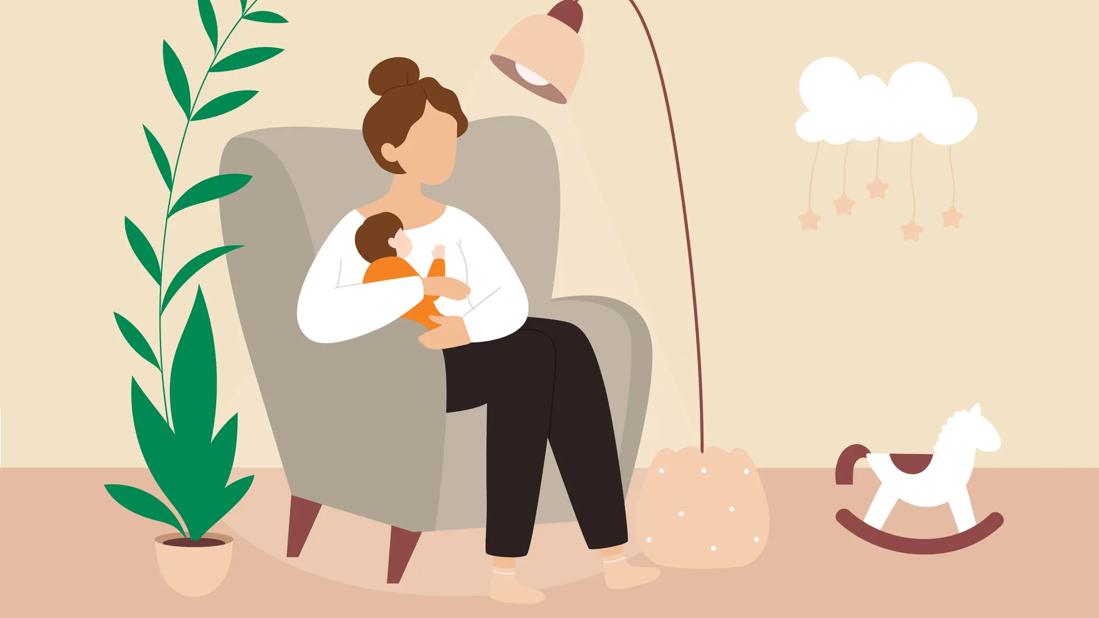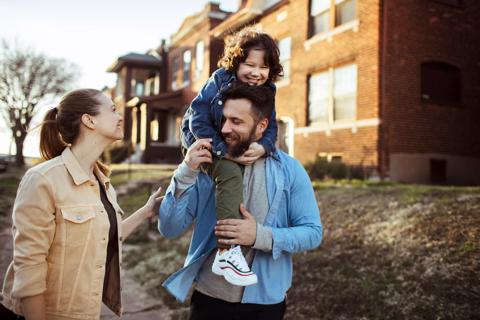Don’t lose sleep over color palettes — your ‘sad beige baby’ couldn’t care less

Have you ever heard of “sad beige parenting”? What about “sad beige babies” and children? Like most trendy topics, the concept of “sad beige” is a product of social media. The story begins with a TikTok creator named Hayley DeRoche.
Advertisement
Cleveland Clinic is a non-profit academic medical center. Advertising on our site helps support our mission. We do not endorse non-Cleveland Clinic products or services. Policy
DeRoche noticed that ads for children’s products have increasingly drifted into the realm of the absurd — in part because neutral tones and muted colors are the aesthetic of the moment. The more expensive the item, it seems, the more likely the ad will look like something out of the Great Depression. An unsmiling little girl stands in a wheat field wearing a sand-colored peasant dress, complete with matching bonnet and a dead-eyed stare. A despondent little boy in a $200 outfit holds a broom made of twigs. And, wait a minute, is that stuffed animal … frowning!?
In her side-splitting voiceover videos, DeRoche introduces herself as the famously grim filmmaker, Werner Herzog. These children’s clothes, toys and décor, DeRoche’s Herzog explains, are all a part of his “Sad Beige Clӧthes For Sad Beige Childrün” product line. Herzog presents one ensemble, saying, “I call this one the ‘Faceless Misëry of Existential Drӕd Romper’. $70, available in cinnamon.”
The videos are hilarious. But they raise an interesting question: Does color — or a lack thereof — impact child development? Is sad beige parenting actually creating … sad beige babies? According to pediatrician Lisa Diard, MD, the answer is no. She explains why.
Advertisement
No, sad beige parenting won’t hurt your child’s visual development, stunt their creativity or make their lives less fun.
“There are parents around the world that raise their child with different color palettes,” Dr. Diard notes. “And they raise wonderful children.”
In many ways, the sad beige debate isn’t really about colors. It’s part of a larger cultural conversation about what it means to be a good parent.
The rise of beige and other neutrals is the result of several different factors. Pop culture is one of the biggest. Many argue the sad beige trend started with celebrities and social media stars, who opt for neutral décor and monochromatic backgrounds for filming.
It’s no surprise that these influencers’ aesthetics influenced broader design trends. Today, a minimalist home filled with shades of taupe and natural materials is a status symbol. To some people, a neutral color pallet equals wealth and taste.
It may sound odd, but this strict design scheme has also come to symbolize a certain kind of freedom.
Becoming a parent involves a lot of sacrifices: Sleep, money and time are just the start. Sensory overload is basically a way of life. Many so-called sad beige parents describe their home aesthetic as a form of self-care — as a way of both asserting their identity and creating a calm, relaxing environment. Sure, most things about life are changing. But their décor doesn’t have to!
“Having a personal aesthetic is harmless — it’s a thing that a parent doesn’t necessarily have to give up — especially in the early years of raising a child.” Dr. Diard says. “The child’s not going to care early on if their room is beige.”
And their room isn’t the only thing they’re going to see either. Think of all the colors your kiddo encounters when you take them out in their stroller. Think about their favorite movies and the time you spend on sensory play. Think about quirky Aunt Hilda’s hat collection! Even the saddest, beigest baby grows up in a colorful world.
The conversation around sad beige parenting isn’t just about the color. It’s about materials, too. The beige wave sweeping American homes reflects a growing preference for natural materials. From non-toxic cleaning products and electric cars to plant-based food dyes and natural fibers, many consumers are trying to limit their — and their children’s — exposure to harmful chemicals. It’s a good impulse.
“As a pediatrician, I feel like less is better,” Dr. Diard shares. “The fewer chemicals in the environment, the better.”
But here’s the thing: Buying wooden toys and cloth diapers can get really expensive really fast. And they aren’t necessarily better for baby. According to Dr. Diard, as long as the plastic toys and synthetic materials your child touches don’t have bisphenol A (BPA) or lead in them, they’ll be OK.
Advertisement
When babies make their grand entrance into the world, they do so with their eyes closed or mostly closed. That’s because infants are extremely sensitive to light. When they do open their eyes, they mostly see objects in their peripheral vision. (Their eyes may also wander or cross while they’re figuring out the whole “seeing” thing, too.) As their retinas develop and their pupils widen, they gain central vision and, eventually, the ability to track objects with their eyes.
So, how does color fit into the picture?
“At birth, babies can detect different intensities,” Dr. Diard explains. “So, they distinguish between brightness and darkness, but they might not understand different colors. That ability typically develops within four months.”
Before babies hit that four-month milestone and begin understanding color, studies suggest they’re most responsive to contrast. That might mean primary colors. But it can also mean black and white — or, yes, black and beige. The color choice itself doesn’t really matter, Dr. Diard clarifies. It’s the difference between the colors that hold baby’s interest.
If you’re sitting in a gray and dusty pink nursery as you read this, rest assured: low contrast is no problem.
Advertisement
“Vision develops with any sort of visual input,” she reassures. “Babies don’t need a full spectrum of color in their home to get there. Home design doesn’t impact your baby’s development. And it doesn’t make a statement about whether you’re a happy parent, a sad parent, a good parent or a bad parent.”
In fact, when it comes to preferences, Dr. Diard says babies’ favorite type of visual input has nothing to do with color: They really like faces, especially yours. Infants also tend to be more interested in (and stimulated by) objects that are close, but not too close. The American Academy of Ophthalmology says the ideal distance is about 3 feet away.
Quick side note: If your wee one decided to arrive early, be aware that the American Academy of Ophthalmology bases their developmental milestones on baby’s due date, not their delivery date. So, while it may seem like your infant’s sight is developing more slowly than their peers, chances are they’re right on schedule. They just have a slightly longer to-do list to tackle. If you have any concerns about your child’s sight, bring it up with their pediatrician.
Dr. Diard’s clear that there’s nothing wrong with a beige aesthetic, if that design choice appeals to you. But there are two important caveats that bear mentioning:
Advertisement
This is one of the things that pushed the sad beige debate into overdrive. A self-described “sad beige mom” made headlines after posting a video in which she used spray paint to “neutralize” her daughter’s toy Christmas tree. Dr. Diard feels that’s taking things too far.
“I imagine there are spray paints that are non-toxic,” she concedes. “But if there’s any possibility of that toy or that furniture going in your child’s mouth, I wouldn't want to add more chemicals into the equation.”
Keeping your décor limited to neutral hues makes a certain kind of sense when your child’s too young to have opinions. But once they’re old enough to know what they like, you’ll have to start making some concessions. After all, your sense of style isn’t the only one that needs accommodating.
“When your little one goes off to kindergarten and sees kids wearing orange dresses and neon pink, they’re going to come home wanting those things,” Dr. Diard poses. “Parents need to concede in that way over time.”
Think of it as a way to teach your child the art of compromise. They get their bright blue bedroom, but the bathroom you two share is all gray, all the time. The kitschy Halloween decorations are welcome, but they only stay up in the living room for two weeks. Create a dedicated display area for their macaroni drawings and clay creations and let them play the part of the esteemed curator.
As Dr. Diard puts it, “Everything in moderation.”
Jokes about sad beige babies are all in good fun, but that’s all they are: jokes. At least, that’s all they should be. “The answer to good parenting isn’t found in the color palette of a baby’s home or clothes,” relays Dr. Diard.
And parents on both sides of the sad beige debate shouldn’t be made to feel guilty, like their parenting choices are hurting their child’s health. Because that’s simply not true.
At the end of the day, the color choices you make in your home aren’t all that important. What matters is that you love and nurture your baby.
Learn more about our editorial process.
Advertisement

The best parenting style balances enforcing rules and showing plenty of love

If parents can’t get along with one another, they’ll need to determine what’s best for their child in separate situations

This burnout is characterized by physical and mental exhaustion and feelings like worry, guilt and overwhelm

It’s important to share the news in an honest and age-appropriate way and to open the lines of communication going forward

Communicating with your family, setting expectations and finding healthy distractions can make life easier once your kiddo flies the coop

Setting specific expectations and praising good behavior are crucial to cultivating discipline

Posting intimate details of your child’s life on social media, like their birth date and school name, can have serious consequences

Keeping open lines of communication and working together as a team for your children are key to co-parenting

The best parenting style balances enforcing rules and showing plenty of love

Tips include cutting back on sugar, focusing on exercise and managing stress

It can be harder to let go when you’ve invested time, energy and emotions — but it might be the healthier choice long term